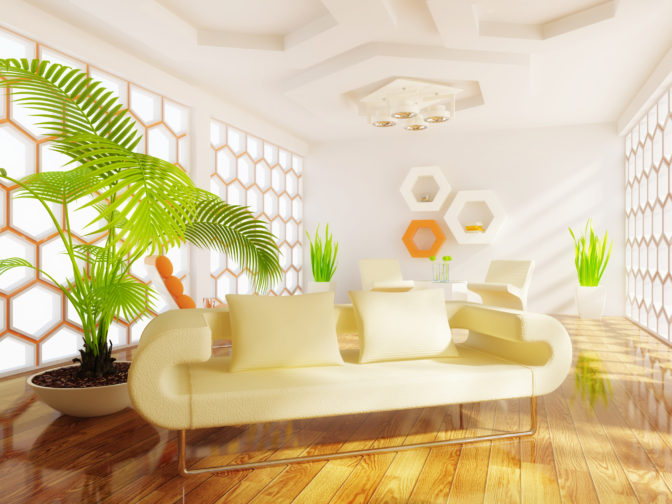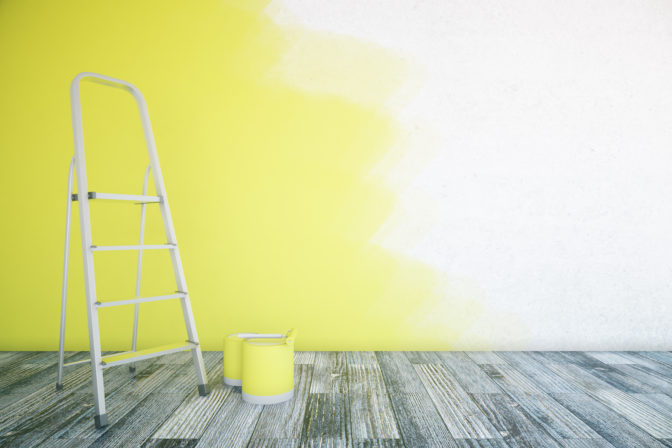When it comes to painting, you can’t go wrong with neutrals. But that doesn’t mean they’re your only option! Many interior decorators—and their clients—are looking for something a little more out-of-the-box.
These 7 creative painting ideas might take some artistry (and some guts!) but for the client who craves more from their paint, they’re the perfect place to start.
1. Stripes

Let’s start out simple—and what’s more simple than stripes? Whether you choose to go vertical or horizontal, stripes are an easy way to add some interest to your client’s room.
According to this post from the DIY Network, painted stripes should fall somewhere between 4—12 inches in width. That way you avoid a look that’s too busy (small stripes) or too heavy (fat stripes). If you’re going the vertical stripe route, do some measurements before diving right in. Measure the wall, then calculate your stripe width from there. You’ll probably want to end up with an odd number of stripes—that means the stripes at either end of the wall are the same color, which helps pull the whole thing together.
2. Half-wall
For another simple paint style that packs a lot of punch, try stopping your paint job halfway up the wall. To get that clean, crisp, and straight line, you’ll definitely want to have some painter’s tape and a laser level on hand!
Pair your colors carefully. Maybe you want to keep the top half of the room a light neutral, while the bottom half uses a bold color that could be overwhelming on its own. Or maybe you want to use this technique to keep a rich, dark color from making a room feel too heavy. Bonus points if you continue the paint job across the door for continuity, like this blogger did.
3. Honeycomb

Hang onto that laser level, stock up on painter’s tape, and add a ruler into the mix! Done right, this design can be stunning, but the technique definitely requires a lot more work. Use your painter’s tape to create a pattern of hexagons on the wall—then fill them in with the color (or colors) of your choice.
Using a single color will create a simple, elegant pattern to add interest to any room. Or, like this dedicated mom, you can add a few colors into the mix for a room that’s full of fun. You can also make things easier on yourself by stealing her hexagon-making trick: create one foam board hexagon, then use it as a guide for placing your tape.
4. Another use for painter’s tape
You’ve probably clued in by now that painter’s tape is an essential for just about any unconventional paint job. The main attraction of painter’s tape lies in its ability to create perfectly straight, crisp lines of paint—but that’s not all it can do!
If your client is looking for a design that’s a little softer and more organic, try creating a line (or a few lines) using torn painter’s tape. The uneven tearing along the bottom gives a soft, unique edge to your painted lines. Just tear one side to contrast the natural sharp edge with the gentle slopes of the tear along the bottom, or tear both sides for a stripe that goes totally organic. Widen your lines by adding extra pieces of tape as needed.
5. Faux wallpaper

Love the look of patterned wallpaper, but prefer to stick with paint? You can easily create your own faux-wallpaper look by adding some stencils or stamps to your paint process. If your clients are DIY-ing their walls, this can be an easier (i.e. less likely to end in disaster) route than going for actual wallpaper.
Plus, the creative freedom you get with stencils basically lets you create the look of custom wallpaper—without the price tag. Help your clients shop for stencils and stamps, or give them some guidance in creating their own for a look that’s one-hundred-percent original. We love this stenciled starbust wallpaper from Anna Joyce!
6. Go abstract
A wall design doesn’t have to be totally structured to work well. Instead of straightforward stripes or a clean half-wall paint job, you can also help your clients come up with their own abstract pattern. An easy route to a stunning result involves creating a series of crisscrossing straight lines with, yes, painter’s tape.
Crisscrossing lines add interest to a wall while keeping it sleek and modern. Keep your lines thin, clean, and evenly spaced, or alternate widths like with this stunning abstract wall.
7. Ombre

Ombre hair, clothing, furniture, and more are all the rage right now. While we can safely say those fads will probably pass, scaling back your ombre for a paint job can have a stunning effect that’s sure to last the years.
Try softening the edges of your client’s room by bringing a dark ceiling color down onto the walls and fading it out into a lighter shade. Done right, this technique creates a cozy space that feels comfortably enclosed—just be careful to avoid making the room seem too “top heavy.” You can also start your ombre with a darker color at floor level, gradually lightening it as you move up the wall.


